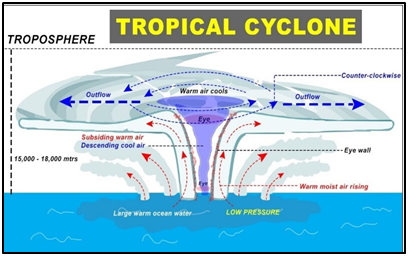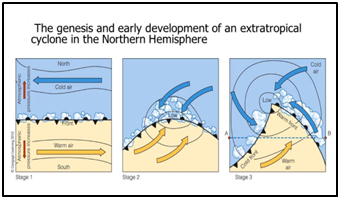Cyclone Michaung to make landfall in Tamil Nadu
02-12-2023
01:16 PM
1 min read

What’s in today’s article?
- Why in news?
- What is Cyclone?
- What is Tropical Cyclone?
- What is Extratropical Cyclone?
- How are the Cyclones named?

Why in news?
- The India Meteorological Department (IMD) has forecast a cyclonic storm, Cyclone Michaung, over the southwest Bay of Bengal on December 3.
- Cyclone Michaung is the fourth tropical cyclone of the year over the Bay of Bengal.
- It is likely to make landfall in the coastal districts of Tamil Nadu and Andhra Pradesh the next day.
Cyclone
- A cyclone is a large-scale system of air that rotates around the centre of a low-pressure area. It is usually accompanied by violent storms and bad weather.
- A cyclone is characterised by inward spiralling winds that rotate anticlockwise in the Northern Hemisphere and clockwise in the Southern Hemisphere.
Tropical Cyclone
- About
- Tropical Cyclone is a weather phenomenon. It is formed only over warm ocean waters near the equator.
- The centre of a cyclone is very calm and clear with very low air pressure.
- The average speed is 120 kmph.
- They have closed isobars which leads to greater velocity.
- Formation
- Warm, moist air rises up and away from the ocean surface, creating an area of low pressure.
- It causes the air from surrounding areas with higher pressure to move towards the low-pressure area.
- This leads to warming up of air and causes it to rise above.
- As the air rises & cools, the water in the air forms clouds.This complete system of clouds and wind spins & grows, along with the ocean’s heat.
- As the wind rotation speed increases, an eye gets formed in the middle.
Extratropical Cyclone
- About
- Extratropical cyclones are low-pressure areas which are generally formed outside the tropics with a latitude range between 30 degrees and 60 degrees.
- They are also known as temperate cyclones.
- These low-pressure systems are associated with cold fronts, warm fronts, and occluded fronts.
- Formation
- In the Northern hemisphere, cold air blows from the north of the front and warm air blows from the south.
- When the pressure descents along the front, the cold air move towards the south, and the warm air moves northwards setting in motion an anticlockwise cyclonic circulation.
- The cyclonic circulation results in a well-built extratropical cyclone, with a cold front and a warm front.
- There are pockets of warm air compressed between the forward and the rear cold air.
- The warm air climbs over the cold air and a series of clouds appear over the sky ahead of the warm front and cause rainfall.
- The cold front approaches the warm air from behind and pushes the warm air up.As an outcome, cumulus clouds develop along the cold front.
- The cold front moves faster than the warm front eventually surpassing the warm front.
- The warm air is entirely lifted and the front is occluded and the cyclone dissipates.They can originate over the land and sea and cover a larger area.
Naming of Cyclones
- Myanmar suggested the name for Cyclone Michaung. The name means "strength and resilience".
- Worldwide, there are six regional specialised meteorological centres (RSMCs) and five regional Tropical Cyclone Warning Centres (TCWCs) mandated for issuing advisories and naming of tropical cyclones.
- The five regional Tropical Cyclone Warning Centres (TCWCs) are:
- ESCAP/WMO Typhoon Committee,
- WMO/ESCAP Panel on Tropical Cyclones,
- It is responsible for naming of cyclones in the Indian Ocean.
- RA I Tropical Cyclone Committee,
- RA IV Hurricane Committee,
- RA V Tropical Cyclone Committee.
- IMD is one of the six RSMCs to provide tropical cyclone and storm surge advisories to under the WMO/Economic and Social Commission for Asia-Pacific (ESCAP).
- WMO/ ESCAPis an inter-governmental regional body jointly established by the World Meteorological Organization (WMO) and the United Nations Economic and Social Commission for Asia-Pacific (ESCAP) in 1972.
- Members – It has 13 countries as its members.
- Bangladesh, India, Iran, Maldives, Myanmar, Oman, Pakistan, Qatar, Saudi Arabia, Sri Lanka, Thailand, United Arab Emirates and Yemen.
- They contribute to a set of names which are assigned sequentially whenever a cyclonic storm develops.
- The list of 169 cyclone names released by IMD in 2020 was provided by these countries — 13 suggestions from each of the 13 countries.
- So, the tropical cyclones forming over different Ocean basins are named by the concerned RSMCs & TCWCs.
Q1) What is World Meteorological Organization (WMO)?
The World Meteorological Organization (WMO) is a specialized agency of the United Nations. It is the UN's authority on the Earth's atmosphere, its interaction with the oceans, the climate it produces, and the distribution of water resources.
Q2) What is Economic and Social Commission for Asia and the Pacific (ESCAP)?
The Economic and Social Commission for Asia and the Pacific (ESCAP) is a regional commission of the United Nations Economic and Social Council. ESCAP is the most inclusive intergovernmental platform in the Asia-Pacific region. It has 53 member states and 9 associate members.
Source: Cyclone Michaung to make landfall in Tamil Nadu: What is a cyclone — and its different types? | Indian Express



